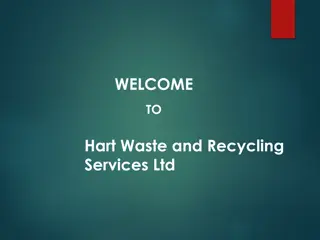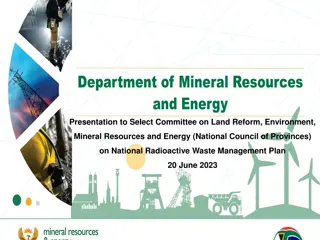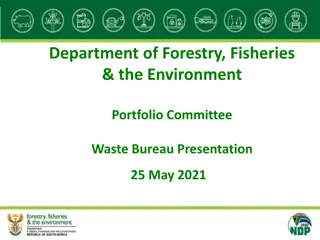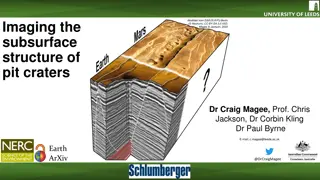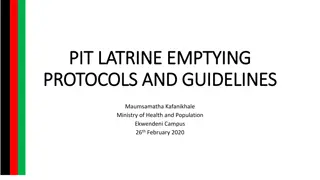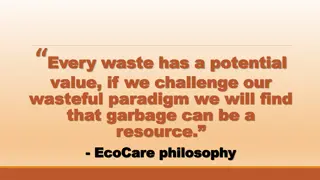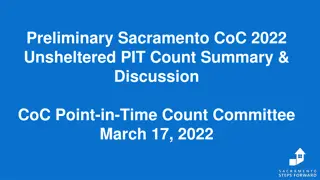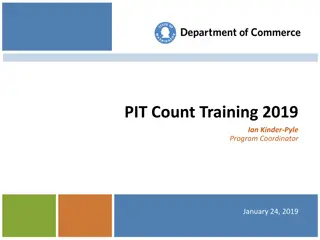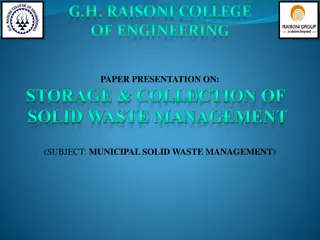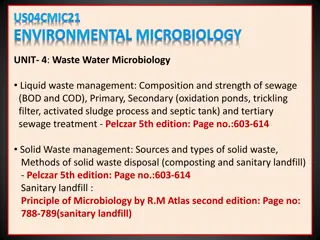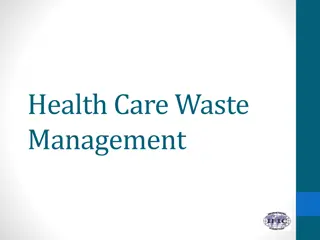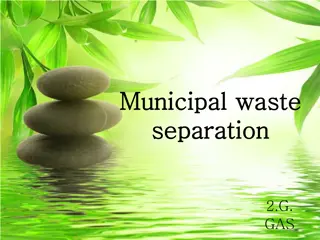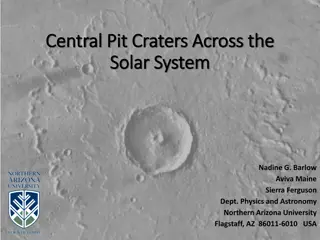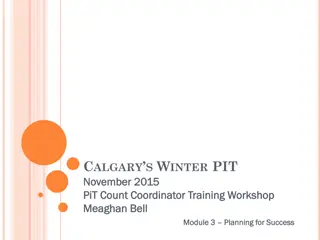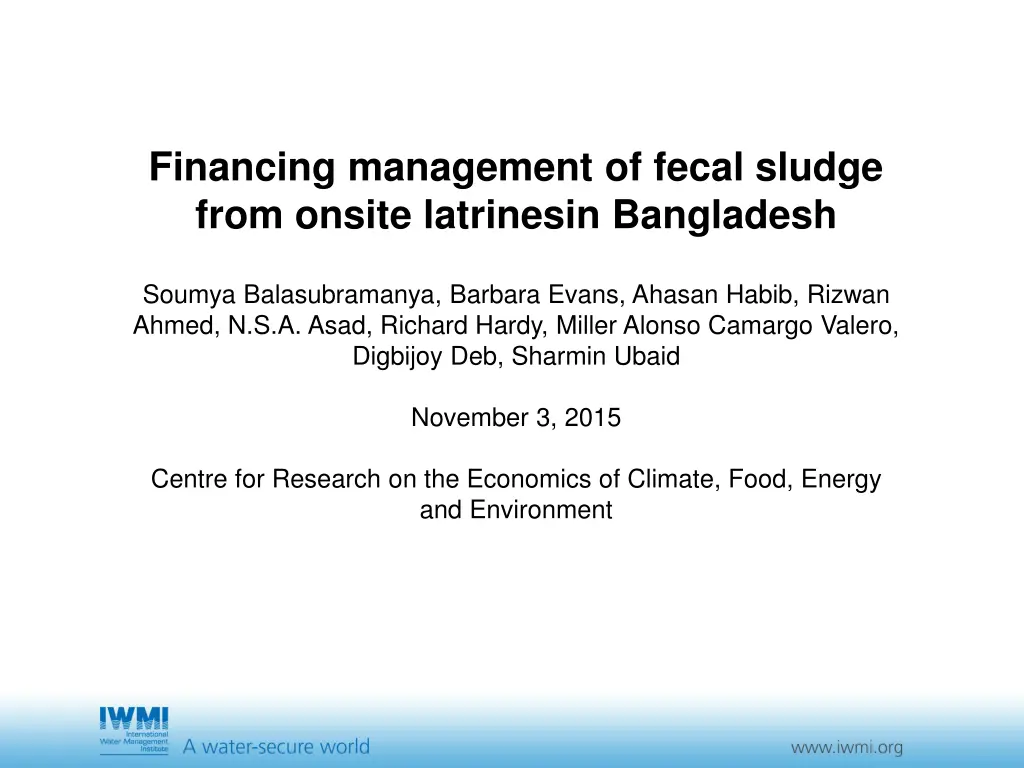
Managing Fecal Sludge in Bangladesh - A Financial Perspective
Explore the innovative financing strategies for managing fecal sludge from onsite latrines in Bangladesh. Discover the partnership, policies, and solutions aimed at sustainable fecal sludge management in rural areas, addressing key questions around disposal, health risks, willingness to pay, transportation models, subsidies, co-composting, and market potential.
Download Presentation

Please find below an Image/Link to download the presentation.
The content on the website is provided AS IS for your information and personal use only. It may not be sold, licensed, or shared on other websites without obtaining consent from the author. If you encounter any issues during the download, it is possible that the publisher has removed the file from their server.
You are allowed to download the files provided on this website for personal or commercial use, subject to the condition that they are used lawfully. All files are the property of their respective owners.
The content on the website is provided AS IS for your information and personal use only. It may not be sold, licensed, or shared on other websites without obtaining consent from the author.
E N D
Presentation Transcript
Financing management of fecal sludge from onsite latrinesin Bangladesh Soumya Balasubramanya, Barbara Evans, Ahasan Habib, Rizwan Ahmed, N.S.A. Asad, Richard Hardy, Miller Alonso Camargo Valero, Digbijoy Deb, Sharmin Ubaid November 3, 2015 Centre for Research on the Economics of Climate, Food, Energy and Environment
DISCIPLINES Economics Environmental Engineering Business Development Social Entrepreneurship Civil Engineering Microbiology Public Health Chemical Engineering WASH (practitioner)
Research partners: IWMI-CGIAR; University of Leeds; NGO Forum for Public Health; Bangladesh University of Engineering and Technology; BRAC; ICDDR-B; Mati Organics Funding: Government of Netherlands Implementation partner: BRAC Policy partner: National Committee for Fecal Sludge Management Policy, Government of Bangladesh (Ministry of Local Government); IRC PURPOSE: 1. Guide BRAC s efforts in FSM 2. Guide IRC s research agenda 3. Feed results into policy in Bangladesh
Managing sludge from rural pit toilets How can the cost of managing sludge be shared between households and governments? Onsite structures: emptied + transport treatment and disposal: co-composting (Local Govt./BRAC run composting businesses from MSW; expanding) http://www.theguardian.com/global- development/gallery/2015/feb/27/bangladesh-toilet-waste- high-value-compost-in-pictures
Many latrines, no safe disposal Rural 22.9 Urban 48.2 Sanitary with water seal No sewerage in rural areas 33.9 Sanitary without water seal 33.5 35.1 Non-Sanitary/ Kutcha 16.2 All toilets are on-site (mostly single pit) 8.2 Open defecation Census of GoB, 2011 2 Managed dumpsite authorized dumping of raw sludge Rural 13.4 Urban 47.7 Managed dumpsite 99% of rural households waste dumped raw Unmanaged dumpsite 55.3 36.1 Bury inside pit 30.5 15.8 Burn Census of GoB, 2011 0.8 0.4
Policy Questions How do rural households currently dispose sludge? What are the health risks from raw sludge? Would households be willing to pay for scheduled emptying and collection of sludge? What collection and transportation model works best for rural areas? What are the costs of emptying and transporting sludge? What subsidy is needed for managing rural fecal sludge? At what points do subsidies need to be targeted to ensure emptying and transportation? Can a co-compost be made from fecal sludge? Is this co-compost safe for use in agriculture? What are the costs of producing co-compost? Is there a market for such a product?
Household study Upazila with high number of pits/sq.km Bhaluka (Mymensingh) Cross-sectional study 1,110 households with single-pit latrines (BRAC) Toilets ~ 5 years old 44 villages. Random sample (40% of BRAC households) Data Latrine management practices (inc. payments) Base bid; follow-up bid GIS data for toilets Perceptions about pit emptying/sludge management
Summary statistics Table 3: Summary statistics for sample of households Mean 4.56 Std Dev 1.71 No. of family members % households where highest education is Class 1-5 Class 6-10 Class 11-12 Beyond Class 12 0.34 0.46 0.08 0.05 2.36 1245.61 1.17 0.67 0.68 0.97 0.47 0.5 0.27 0.22 1.14 1077.83 0.66 0.47 0.47 0.17 No. of concrete liners in the pit Annual household income (USD) No. Women/household making toilet-management decisions % households with non-farming income source % households with brick walls % households with metal sheet roof Source: Authors' data
Household behaviors Pit latrine use (n =1,102) % households yet to empty their pits % households that emptied pit at least once % households where (first pit toilet ==> open defacation) % households where (pit toilet in 2014 first pit toilet) % households where (pit toilet in 2014 = first pit toilet) % households with a pit toilet in 2014 0 0.1 0.2 0.3 0.4 0.5 0.6 0.7 0.8 0.9 1
Household behaviors (2) Table 4: Pit management of households emptying pit at least once (n=222) Obs 222 222 195 222 198 Mean 2.07 0.88 0.99 0.9 0.03 Std Error 0.23 0.06 0.02 0.06 0.03 No. times pit was emptied % households that hired sweeper for emptying pit % households that paid sweeper when hired % households that dumped waste next to their house % households that reused buried waste Table 5: Pit management of households yet to empty their pits (n=827) Obs 827 827 827 Mean 0.91 0.91 0.06 Std Error 0.03 0.03 0.02 % households planning to hire sweeper when pit fills % households planning to dump waste near their house % households that plan to build a new pit
What are households paying now? Asked pit emptiers how they charge a fee Asked household what they had paid when emptied (n=222) Effect 10.46 Std Error 7.12 Family size Highest schooling Class 1-5 Class 6-10 Class 11-12 Beyond Class 12 69.08 65.10 62.21 13.48 65.65 61.83 83.07 95.91 9.57 0.03 21.24 24.33 29.52 68.21 12.14 185 0.0004 0.15 No. of concrete liners in the pit Annual household income (USD) No. Women/household making toilet-management decisions Household has a non-farm source of income (Indicator) Household lives in dwelling with brick walls (Indicator) Household lives in dwelling with roof of metal sheets (indicator) Age of the pit latrine N Prob> F R-squared Lower bound WTP 0.05 22.01 42.46 -25.37 10.78 20.10 337.28 48.45
Estimating willingness to pay Would households pay for organized emptying and collection? Randomly assigned bids to households in a village Base bid Follow-up bid | base bid accepted Follow-up bid | base bid rejected 400 600 300 600 700 400 700 800 600 800 1000 700
Estimating willingness to pay ? ? ? ?1 ? ? ?2 ? ? ?2 ?? ?? ???? ?? ?? ?? + ?? ?? ? ? ? ?=1 ? ? ?2 ? ? ?1 ?? ?? + ?? ?? ?? ? ? ? ? ?2 ???? 1 + ?? ?? 7 ? ??? = ? ?
Estimating willingness to pay Table 6: Upper bound on WTP for emptying and transportation Number of samples = 100 Number of obs/ sample = 100 Normal-based Bias-corrected 95% CI Observed Boostrap Coeff Std Err z P > |z| CI WTP 506.66 13.15 38.54 0.000 480.89-532.42 482.80-534.01 Simple probit using the base bids and their responses: BDT 436 (24)
Emptying and Transport Costs Estimate volume of sludge generated by population a year Identify viable emptying options Identify viable transporting options Four options emerge: estimate capital costs and operational costs for each ( model calculates the number of pits to be emptied; equipment; labor needed..) 25 year period
Emptying and Transport Costs Study Area Bhaluka Upazilla 95 Villages in 11 Unions; population approx. 400,000 Approx. 95,900 households Data used: Census 2011 (population) Survey data (latrine practices and features) GPS data (distances, state of roads etc.)
Emptying options Assessed mechanical methods of emptying pits Diaphragm pumps Gulpher Diesel Electric Worked with local pit emptiers emptied near full and half-full pits Observations Debriefing sessions DWASA emptiers
Gulpher 10-15K Diaphragm 25-30K Diesel 20-25K Electric 10-15K Capital costs/ Purchasing costs (BDT) Energy requirements Maintenance costs (annual, BDT) Ease of use in rural areas Ease of handling Minimun labour requirement (per pit) Van needed for transporting pump Ideal pit depth Pit emptying charges (per pit; BDT) Spillage during emptying Probability of damaging latrine during use Preparation time (minutes) Pit emptying time (minutes) None 1-2K Difficult Difficult 2 Yes 3-5ft 0.5-1.5K Yes High 15-20 20-30 None 1-2K Easy Easy 1 No 3-10 ft 0.5-1.5K No Low 10-15 15-20 Diesel 3-5K Difficult Difficult 2 Yes 10-15 ft 1.5-2K Yes Med 20-30 5-10 Electricity 2-3K Easy Difficult 1 No 3-10 ft 1.5-2K Yes Low 15-20 101-5 Hand emptying vs diaphragm pump Water for a food-secure world www.iwmi.org
Transportation options Treatment site has to be located at upazila HQ: 2 options Small trucks carry 6 plastic containers of 20 liters from village to upazila HQ OR Transfer point at Union Parishad; small trucks, then large trucks
Emptying and Transportation Assessed four methods for emptying and transportation for managing the amount of fecal sludge produced in a year. Lower cost method Diaphragm pumps for emptying Combined transportation method using smaller trucks (from villages to Union) and larger tankers (from Union to Upazila)
Costs and subsidy (tentative) Volume of fecal sludge produced a year : 6,641 ?3 Need 59 small trucks and 1 large truck (120 people); need 18 pumps (18 emptiers) Annual operating costs BDT 4.56 million (USD 58,461) Avg. cost of empting/?3 = BDT 687 From community can raise: BDT 1.6 million - BDT 2.1 million (USD 20,306 to USD 26,331) Avg. WTP/ ?3 = BDT 238-309 Gap: BDT 3 million to 2.2 million (~67% to 57% of OC) Annualized capital costs: BDT 3 million (USD 37,764 )
Next steps Check our numbers Where to target subsidies? How to monitor? How to subsidize? Co-composing: costs? Markets for compost

